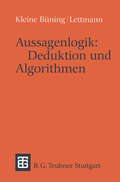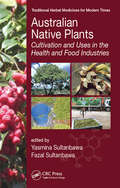- Table View
- List View
Ausrückbare Kupplungen für Wellen und Räderwerke: Theoretische Grundlage und vergleichende Beurteilung ausgeführter Konstruktionen
by Ad ErnstAussagenlogik: Deduktion und Algorithmen (Leitfäden und Monographien der Informatik)
by Theodor LettmannAusschreibungshilfe Ausbau: Standardleistungsbeschreibungen — Baupreise — Firmenverzeichnis
by Martin MittagIm Buch werden die Standardleistungsbeschreibungen nach DIN 276, die für den Ausbau relevant sind, detailliert dargestellt. Hinweise und einzelne Beispiele innerhalb der Standardleistungsbeschreibungen machen darüber hinaus den Anwender auf wichtige zu beachtende Punkte bei der Ausschreibung aufmerksam. Im Anschluss an jede Standardleistungsbeschreibung werden zu den Einzelpositionen Baupreise angegeben, die bei Berücksichtigung der angegebenen Korrekturfaktoren einen sehr guten und nachweisbaren Hinweis auf die anfallenden Kosten pro Position geben. Zusätzlich liefert das umfangreiche Firmenverzeichnis die entsprechenden Hersteller zu den Produkten, die ausgeschrieben werden. Die Kontaktaufnahme wird dadurch erheblich vereinfacht.
Ausschreibungshilfe Außenanlagen und Tiefbau: Standardleistungsbeschreibungen — Baupreise
by Martin MittagDie Standardleistungsbeschreibungen nach DIN 276, die für Außenanlagen und Tiefbau relevant sind, werden detailliert dargestellt. Hinweise und einzelne Beispiele innerhalb der Standardleistungsbeschreibungen machen darüber hinaus den Anwender auf wichtige zu beachtende Punkte bei der Ausschreibung aufmerksam. Im Anschluss an die Standardleistungsbeschreibung werden zu den Einzelpositionen Baupreise angegeben, die bei Berücksichtigung der angegebenen Korrekturfaktoren einen sehr guten und nachweisbaren Hinweis auf die anfallenden Kosten pro Position geben.
Ausschreibungshilfe Haustechnik: Standardleistungsbeschreibungen — Baupreise — Firmenverzeichnis
by Martin MittagIm Buch werden die Standardleistungsbeschreibungen nach DIN 276, die für den technischen Ausbau relevant sind, detailliert dargestellt. Hinweise und einzelne Beispiele innerhalb der Standardleistungsbeschreibungen machen darüber hinaus den Anwender auf wichtige zu beachtende Punkte bei der Ausschreibung aufmerksam. Im Anschluss an jede Standardleistungsbeschreibung werden zu den Einzelpositionen Baupreise angegeben, die bei Berücksichtigung der angegebenen Korrekturfaktoren einen sehr guten und nachweisbaren Hinweis auf die anfallenden Kosten pro Position geben. Zusätzlich liefert das umfangreiche Firmenverzeichnis die entsprechenden Hersteller zu den Produkten, die ausgeschrieben werden. Die Kontaktaufnahme wird dadurch erheblich vereinfacht.
Ausschreibungshilfe Rohbau: Standardleistungsbeschreibungen — Baupreise — Firmenverzeichnis
by Martin MittagIm Buch werden die Standardleistungsbeschreibungen nach DIN 276, die für den Rohbau relevant sind, detailliert dargestellt. Hinweise und einzelne Beispiele innerhalb der Standardleistungsbeschreibungen machen darüber hinaus den Anwender auf wichtige zu beachtende Punkte bei der Ausschreibung aufmerksam. Im Anschluss an jede Standardleistungsbeschreibung werden zu den Einzelpositionen Baupreise angegeben, die bei Berücksichtigung der angegebenen Korrekturfaktoren einen sehr guten und nachweisbaren Hinweis auf die anfallenden Kosten pro Position geben. Zusätzlich liefert das umfangreiche Firmenverzeichnis die entsprechenden Hersteller zu den Produkten, die ausgeschrieben werden. Die Kontaktaufnahme wird dadurch erheblich vereinfacht.
Aussendung und Empfang elektrischer Wellen
by Reinhold RüdenbergDieser Buchtitel ist Teil des Digitalisierungsprojekts Springer Book Archives mit Publikationen, die seit den Anfängen des Verlags von 1842 erschienen sind. Der Verlag stellt mit diesem Archiv Quellen für die historische wie auch die disziplingeschichtliche Forschung zur Verfügung, die jeweils im historischen Kontext betrachtet werden müssen. Dieser Titel erschien in der Zeit vor 1945 und wird daher in seiner zeittypischen politisch-ideologischen Ausrichtung vom Verlag nicht beworben.
Außenräumen (Werkstattbücher #80 )
by Artur SchatzDieser Buchtitel ist Teil des Digitalisierungsprojekts Springer Book Archives mit Publikationen, die seit den Anfängen des Verlags von 1842 erschienen sind. Der Verlag stellt mit diesem Archiv Quellen für die historische wie auch die disziplingeschichtliche Forschung zur Verfügung, die jeweils im historischen Kontext betrachtet werden müssen. Dieser Titel erschien in der Zeit vor 1945 und wird daher in seiner zeittypischen politisch-ideologischen Ausrichtung vom Verlag nicht beworben.
Außenwandkonstruktionen mit optimalem Wärmeschutz: Grundlagen u. Richtwerte, Stoffwerttab., 58 Aussenwände in je 5 Varianten
by Friedrich Hebgen Friedrich HeckÄußere Ballistik
by Hellmuth Molitz Reinhold StrobelJahrzehntelang ist das "Lehrbuch der Ballistik" von C. CRANZ nicht nur in Deutschland das Standardwerk für dieses Arbeitsgebiet gewesen. Es erschien zunächst 1896 im Verlag B. G. Teubner, Leipzig, als "Kom pendium der theoretischen äußeren Ballistik". Mit dem Aufbau und der Leitung des Ballistischen Laboratoriums an der ehemaligen Militär technischen Akademie in Berlin-Charlottenburg im Jahre 1903 übernahm C. CRANZ die Verpflichtung, das Gesamtgebiet der Ballistik zu bearbeiten. Um einerseits die zahlreichen neueren Arbeiten - viele davon aus seinem eigenen Laboratorium stammend - zu erfassen und andererseits ein Lehrbuch für seine Schüler zu schaffen, wandelte CRANZ das "Kom pendium" in ein "Lehrbuch der Ballistik" um, das die gesamte theoreti sche und experimentelle Ballistik zum Gegenstand haben sollte. Der erste Band, der die theoretische äußere Ballistik behandelte, erschien 1910 im Springer-Verlag, Berlin (zugleich als 2. Auflage des Kompendiums). Band III, herausgegeben im Jahre 1913, enthielt die experimentelle Ballistik; Band IV brachte ballistische Tabellen und Diagramme sowie eine Reihe von photographischen Aufnahmen. Band II, der die innere Ballistik behandeln sollte, erschien damals noch nicht. Unter Berücksichtigung der inzwischen gesammelten Erfahrungen wurde dann das ganze Werk, nachdem der I. Band vier Auflagen erfahren hatte, neu herausgegeben, dieses Mal einschließlich Band II "Innere Ballistik". (Band I erschien im Jahre 1925, Band II 1926, Band III 1927.) Neuere Arbeiten und Entwicklungen wurden in einen Ergänzungsband, der 1936 herauskam, aufgenommen.
Äussere Ballistik: Oder Theorie der Bewegung des Geschosses von der Mündung der Waffe ab bis zum Eindringen in das Ziel
by O. von Eberhard K. BeckerDieser Buchtitel ist Teil des Digitalisierungsprojekts Springer Book Archives mit Publikationen, die seit den Anfängen des Verlags von 1842 erschienen sind. Der Verlag stellt mit diesem Archiv Quellen für die historische wie auch die disziplingeschichtliche Forschung zur Verfügung, die jeweils im historischen Kontext betrachtet werden müssen. Dieser Titel erschien in der Zeit vor 1945 und wird daher in seiner zeittypischen politisch-ideologischen Ausrichtung vom Verlag nicht beworben.
Außergewöhnliche Druck- und Temperatursteigerungen bei Dieselmotoren: Eine Untersuchung
by Richard ColellDieser Buchtitel ist Teil des Digitalisierungsprojekts Springer Book Archives mit Publikationen, die seit den Anfängen des Verlags von 1842 erschienen sind. Der Verlag stellt mit diesem Archiv Quellen für die historische wie auch die disziplingeschichtliche Forschung zur Verfügung, die jeweils im historischen Kontext betrachtet werden müssen. Dieser Titel erschien in der Zeit vor 1945 und wird daher in seiner zeittypischen politisch-ideologischen Ausrichtung vom Verlag nicht beworben.
Außergewöhnliche Druck- und Temperatursteigerungen bei Dieselmotoren: Eine Untersuchung
by Richard ColellDieser Buchtitel ist Teil des Digitalisierungsprojekts Springer Book Archives mit Publikationen, die seit den Anfängen des Verlags von 1842 erschienen sind. Der Verlag stellt mit diesem Archiv Quellen für die historische wie auch die disziplingeschichtliche Forschung zur Verfügung, die jeweils im historischen Kontext betrachtet werden müssen. Dieser Titel erschien in der Zeit vor 1945 und wird daher in seiner zeittypischen politisch-ideologischen Ausrichtung vom Verlag nicht beworben.
Außerplaninstandhaltung von Eisenbahnfahrzeugen: Algorithmus für einen vorhersagbaren Schadindex
by Ingo HeinrichIngo Heinrich untersucht die außerplanmäßige Instandhaltung und beschreibt die methodische Herleitung eines mathematischen Modells, um den Grad der Schädigung einer Flotte von Eisenbahnfahrzeugen in eine valide Korrelation mit vorhandenen betrieblichen Ressourcen zu bringen. Diese Wechselbeziehung wird in einen Schadindex überführt und mittels eines Prognosemodells in seinem zeitlichen Verlauf vorhersagbar dargestellt. Die Prognose berücksichtigt auch die Möglichkeit zur iterativen Anpassung, beispielsweise das zukünftige Schädigungsverhalten in Abhängigkeit einer veränderten Fahrzeugzahl oder einer Umstellung der Mitarbeiterbesetztzeiten in den Instandhaltungswerken. Damit erhalten Eisenbahnver-kehrsunternehmen mehr Handlungsspielräume zur Verfolgung ihrer strategischen und wirtschaftlichen Ziele.
Aussichten der europäischen Flugzeugproduktion. Entwicklung der Festigkeitsrechnung und Festigkeitsversuche im Flugzeugbau seit 1925 (Arbeitsgemeinschaft für Forschung des Landes Nordrhein-Westfalen #158)
by Giuseppe GabrielliAustauschbare Einzelteile im Maschinenbau: Die technischen Grundlagen für ihre Herstellung
by Neumann NeumannAustenitic Steels at Low Temperatures (Cryogenic Materials Series)
by T. Horiuchi R. P. ReedThe need for alternate energy sources has led to the develop ment of prototype fusion and MHD reactors. Both possible energy systems in current designs usually require the use of magnetic fields for plasma confinement and concentration. For the creation and maintenance of large 5 to 15 tesla magnetic fields, supercon ducting magnets appear more economical. But the high magnetic fields create large forces, and the complexities of the conceptual reactors create severe space restrictions. The combination of re quirements, plus the desire to keep construction costs at a mini mum, has created a need for stronger structural alloys for service at liquid helium temperature (4 K). The complexity of the required structures requires that these alloys be weldable. Furthermore, since the plasma is influenced by magnetic fields and since magnet ic forces from the use of ferromagnetic materials in many configur ations may be additive, the best structural alloy for most applica tions should be nonmagnetic. These requirements have led to consideration of higher strength austenitic steels. Strength increases at low temperatures are achieved by the addition of nitrogen. The stability of the austenitic structure is retained by adding manganese instead of nickel, which is more expensive. Research to develop these higher strength austenitic steels is in process, primarily in Japan and the United States.
Austenitic TRIP/TWIP Steels and Steel-Zirconia Composites: Design of Tough, Transformation-Strengthened Composites and Structures (Springer Series in Materials Science #298)
by Horst Biermann Christos G. AnezirisThis open access book presents a collection of the most up-to-date research results in the field of steel development with a focus on pioneering alloy concepts that result in previously unattainable materials properties. Specifically, it gives a detailed overview of the marriage of high-performance steels of the highest strength and form-ability with damage-tolerant zirconia ceramics by innovative manufacturing technologies, thereby yielding a new class of high-performance composite materials. This book describes how new high-alloy stainless TRIP/TWIP steels (TRIP: TRansformation-Induced Plasticity, TWIP: TWinning-induced Plasticity) are combined with zirconium dioxide ceramics in powder metallurgical routes and via melt infiltration to form novel TRIP-matrix composites. This work also provides a timely perspective on new compact and damage-tolerant composite materials, filigree light-weight structures as well as gradient materials, and a close understanding of the mechanisms of the phase transformations.With a detailed application analysis of state-of-the-art methods in spatial and temporal high-resolution structural analysis, in combination with advanced simulation and modelling, this edited volume is ideal for researchers and engineers working in modern steel development, as well as for graduate students of metallurgy and materials science and engineering.
Australian Guidebook for Structural Engineers
by Lonnie PackThis guidebook is a practical and essential tool providing everything necessary for structural design engineers to create detailed and accurate calculations. Basic information is provided for steel, concrete and geotechnical design in accordance with Australian and international standards. Detailed design items are also provided, especially relevant to the mining and oil and gas industries. Examples include pipe supports, lifting analysis and dynamic machine foundation design. Steel theory is presented with information on fabrication, transportation and costing, along with member, connection, and anchor design. Concrete design includes information on construction costs, as well as detailed calculations ranging from a simple beam design to the manual production of circular column interaction diagrams. For geotechnics, simple guidance is given on the manual production and code compliance of calculations for items such as pad footings, piles, retaining walls, and slabs. Each chapter also includes recommended drafting details to aid in the creation of design drawings. More generally, highly useful aids for design engineers include section calculations and force diagrams. Capacity tables cover real-world items such as various slab thicknesses with a range of reinforcing options, commonly used steel sections, and lifting lug capacities. Calculations are given for wind, seismic, vehicular, piping, and other loads. User guides are included for Space Gass and Strand7, including a non-linear analysis example for lifting lug design. Users are also directed to popular vendor catalogues to acquire commonly used items, such as steel sections, handrails, grating, grouts and lifting devices. This guidebook supports practicing engineers in the development of detailed designs and refinement of their engineering skill and knowledge.
Australian Guidebook for Structural Engineers
by Lonnie PackThis guidebook is a practical and essential tool providing everything necessary for structural design engineers to create detailed and accurate calculations. Basic information is provided for steel, concrete and geotechnical design in accordance with Australian and international standards. Detailed design items are also provided, especially relevant to the mining and oil and gas industries. Examples include pipe supports, lifting analysis and dynamic machine foundation design. Steel theory is presented with information on fabrication, transportation and costing, along with member, connection, and anchor design. Concrete design includes information on construction costs, as well as detailed calculations ranging from a simple beam design to the manual production of circular column interaction diagrams. For geotechnics, simple guidance is given on the manual production and code compliance of calculations for items such as pad footings, piles, retaining walls, and slabs. Each chapter also includes recommended drafting details to aid in the creation of design drawings. More generally, highly useful aids for design engineers include section calculations and force diagrams. Capacity tables cover real-world items such as various slab thicknesses with a range of reinforcing options, commonly used steel sections, and lifting lug capacities. Calculations are given for wind, seismic, vehicular, piping, and other loads. User guides are included for Space Gass and Strand7, including a non-linear analysis example for lifting lug design. Users are also directed to popular vendor catalogues to acquire commonly used items, such as steel sections, handrails, grating, grouts and lifting devices. This guidebook supports practicing engineers in the development of detailed designs and refinement of their engineering skill and knowledge.
Australian Native Plants: Cultivation and Uses in the Health and Food Industries (Traditional Herbal Medicines for Modern Times)
by Yasmina Sultanbawa Fazal SultanbawaAustralian Native Plants: Cultivation and Uses in the Health and Food Industries provides a comprehensive overview of native food crops commercially grown in Australia that possess nutritional and health properties largely unknown on a global basis. These native foods have been consumed traditionally, have a unique flavor diversity, offer significant health promoting effects, and contain useful functional properties. Australian native plant foods have also been identified for their promising antioxidant and antimicrobial properties that have considerable commercial potential. This book is divided into three parts: The first part reviews the cultivation and production of many Australian native plants (ANP), including Anise Myrtle, Bush Tomato, Desert Raisin, Davidson’s Plum, Desert Limes, Australian Finger Lime, Kakadu Plum, Lemon Aspen, Lemon Myrtle, Muntries, Native Pepper, Quandong, Riberry, and Wattle Seed. It then examines the food and health applications of ANP and discusses alternative medicines based on aboriginal traditional knowledge and culture, nutritional characteristics, and bioactive compounds in ANP. In addition, it reviews the anti-obesity and anti-inflammatory properties of ANP and discusses food preservation, antimicrobial activity of ANP, and unique flavors from Australian native plants. The third section covers the commercial applications of ANP. It focuses on native Australian plant extracts and cosmetic applications, processing of native plant foods and ingredients, quality changes during packaging, and storage of Australian native herbs. The final few chapters look into the importance of value chains that connect producers and consumers of native plant foods, new market opportunities for Australian indigenous food plants, and the safety of using native foods as ingredients in the health and food sectors.
Australian Native Plants: Cultivation and Uses in the Health and Food Industries (Traditional Herbal Medicines for Modern Times)
by Yasmina Sultanbawa and Fazal SultanbawaAustralian Native Plants: Cultivation and Uses in the Health and Food Industries provides a comprehensive overview of native food crops commercially grown in Australia that possess nutritional and health properties largely unknown on a global basis. These native foods have been consumed traditionally, have a unique flavor diversity, offer significant health promoting effects, and contain useful functional properties. Australian native plant foods have also been identified for their promising antioxidant and antimicrobial properties that have considerable commercial potential. This book is divided into three parts: The first part reviews the cultivation and production of many Australian native plants (ANP), including Anise Myrtle, Bush Tomato, Desert Raisin, Davidson’s Plum, Desert Limes, Australian Finger Lime, Kakadu Plum, Lemon Aspen, Lemon Myrtle, Muntries, Native Pepper, Quandong, Riberry, and Wattle Seed. It then examines the food and health applications of ANP and discusses alternative medicines based on aboriginal traditional knowledge and culture, nutritional characteristics, and bioactive compounds in ANP. In addition, it reviews the anti-obesity and anti-inflammatory properties of ANP and discusses food preservation, antimicrobial activity of ANP, and unique flavors from Australian native plants. The third section covers the commercial applications of ANP. It focuses on native Australian plant extracts and cosmetic applications, processing of native plant foods and ingredients, quality changes during packaging, and storage of Australian native herbs. The final few chapters look into the importance of value chains that connect producers and consumers of native plant foods, new market opportunities for Australian indigenous food plants, and the safety of using native foods as ingredients in the health and food sectors.
Australia’s Energy Transition: Balancing Competing Demands and Consumer Roles
by Glen CurrieThis book studies Australia, a country characterized by the highest concentration of domestic photovoltaic systems. In addition, the high level of solar energy that Australia receives makes these systems a significant part of its energy mix. International electricity system managers take note; your systems are heading this way. The energy transition is an emerging field, and few texts have been published that can help energy planners as this book does. The research presented is sociotechnical in nature, and reveals that the main challenge in the energy transition is its emerging social role. Very few works combine the social and technical fields of energy. Given its scope, the book will appeal to readers interested in policy, regulation, and energy systems, including government employees involved in energy system management all around the world.






















